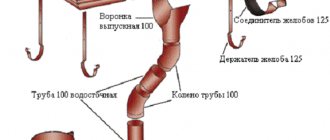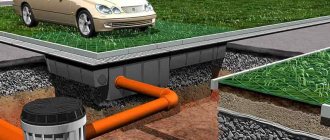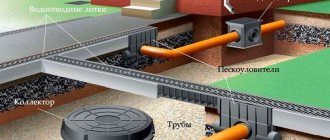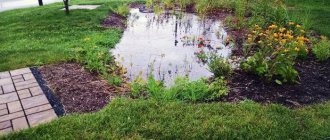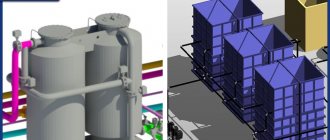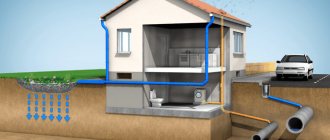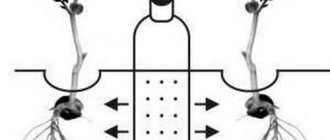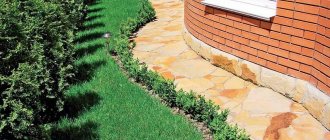Storm drainage (popularly “storm sewer”) is a complex engineering structure that includes a number of elements. You can install such a system yourself. But it is better to entrust the design of storm drainage to specialized specialists, so as not to make mistakes with calculations and compliance with all sanitary standards.
In the article below, read about the types of storm drains according to engineering and technical parameters, as well as the features of calculation, design, installation and operation.
A well-constructed system will ensure high-quality removal of precipitation and melt water in the spring.
Types of stormwater
Sewage systems designed to drain melt and rainwater are of two types:
Point collection of water from the roofs of buildings. Its main elements are rainwater inlets located directly under the drainpipes. All catchment points are provided with special sedimentation tanks for sand (sand traps) and are connected to each other by a single pipeline. Such a sewer system is a relatively inexpensive engineering structure that can cope with drainage from roofs and courtyards.
Linear is a more complex type of sewer system designed to collect water from the entire site. The system includes a network of above-ground and underground drains located along the perimeter of the site, along walkways and the yard. Typically, water from drainage systems located along the foundation or protecting the garden and vegetable beds is discharged into a common linear stormwater collector. The system is extremely sensitive to slope towards the collectors. If it is not followed, water will stagnate in the pipes and the drainage system will not be able to fulfill its functions.
Based on the method of water drainage, storm drains are divided into:
Open systems that collect water through trays and deliver it to collectors. The trays are covered with shaped gratings on top, which perfectly complement the landscape design and provide protection from debris. Such systems are installed in small private areas.
Such a project is implemented in practice by constructing canals that connect drainage trays to each other and, ultimately, drain the collected water beyond the intended territory.
Elements of storm drainage systems have an open connection with the environment. The construction of such structures requires a relatively small amount of resources and materials.
For mixed type drainage systems - hybrid systems that include elements of closed and open systems. They are most often built to save the family budget. External elements are easier to install and cost less.
The design of mixed storm sewerage is carried out based on the rationality of operating the system in individual areas of the area. The financial side of its implementation plays an important role in the decision to choose a combined option.
For closed systems , consisting of rain inlets, trays, pipelines and a collector that opens into a ravine or reservoir. This is an ideal solution for draining streets, industrial areas and suburban areas with a large area.
The closed-type storm sewer system should be considered more advanced in design terms. Hidden drainage lines are being built here, as well as a system of storm water inlets - special intermediate storage tanks.
In the photo: Open type storm drainage system in industrial design. The main structural elements are concrete trays, on top of which lattice metal sheets are laid. The same principle is used to build open stormwater drainage systems for private housing construction.
The collected water is discharged through networks of pipelines laid and hidden underground. As a rule, the collected products of atmospheric precipitation are discharged to treatment facilities and then into the waters of natural reservoirs.
a ditch (trough) system for collecting and draining rainwater should be highlighted This storm drainage system, together with its simple manufacturing scheme, is characterized by universal operation.
Ditch storm drainage has the advantage that, together with the function of draining rainwater, it can act as a supplier of moisture for agricultural plantings. It is also an economical construction option compared to other projects.
Thanks to the ditch design, it is possible to organize not only quite effective drainage of precipitation products. The same system can be successfully used as an irrigation structure, for example, for the needs of a household (dacha) farm.
Types of storm drainage
Designing storm drainage requires the developer to know how to collect and transport wastewater. There are different design options for a storm drainage system. By transportation method:
- closed channels. Water enters receiving wells, from where it passes through an underground pipe system to a treatment plant, or to a discharge point. The most complex option, requiring precise calculation of the cross-section of pipes, determination of the number of drains, etc.;
- open lines . The wastewater moves through an above-ground system of trays or gutters. The option is convenient due to ease of maintenance and cleaning of channels. Often used in urban environments, where rainwater contains a large amount of debris and sand;
- mixed . They consist of open and closed areas. This option is most common, as it allows you to save on excavation work.
According to the method of collecting water:
- point . This is a system of receiving wells connected by pipes. It collects runoff from low areas, areas under drainpipes, etc.;
- linear _ They consist of long receiving chutes. This is a good way to collect moisture from large areas, paved parking lots and other areas.
The choice of the appropriate option is determined by important criteria:
- configuration and layout of the site;
- the condition of its surface;
- way of using it.
It is necessary to take into account that effective collection of wastewater will be needed in any case. A properly designed storm drainage system ensures the most complete removal of rainwater. Otherwise, water will begin to flow into lowlands, penetrate into basements, and destroy the foundations of buildings and structures.
When is a shower needed?
The arrangement of storm drainage is directly related to climatic conditions and soil conditions in a particular area. The more wet the area is, the more acute the need for installing storm drains.
Factors indicating the need for water drainage:
- regularly falling heavy precipitation (heavy rains, heavy snow);
- high groundwater level;
- flooding of basements and cellars in the spring;
- the appearance of dampness on the walls and foundation (the appearance of mold, cracks);
- damage to paths and yard surfaces due to rain and melting snow;
- slow drying of the soil (stagnation of water in puddles).
Design Features
Any sewage system must comply with the technical requirements displayed in a special document - SNiP. This also applies to storm drains. The project is drawn up taking into account all the technical requirements of SNiP.
In the future, it is necessary to strictly adhere to the design documentation, which will indicate the slope angles of the trays and pipelines, the length of communications, and the building materials, equipment and tools necessary for the work.
For an accurate calculation you will need:
- Get data on average annual precipitation. The local weather service will provide the necessary information.
- Determine the area of the drains. To do this, calculate the area of the roof and the entire territory (if not only the yard will be drained).
- Determine the quality of the soil. Sand and sandy loam absorb moisture well, which cannot be said about loam and rocky soils. Also, absorption slows down the presence of plants on the site - the root system facilitates the drainage of water, but prevents its rapid absorption.
- Find out the location of other communications (main sewerage, water supply, drains).
An important indicator is the freezing point of the soil. If the pipes are laid below this point, the sewerage system will function without interruption even in winter. If the depth is insufficient, the ice will block all pipes and trays, preventing the outflow of water. Correct deepening of the pipeline guarantees a long service life of the entire system.
The problem of soil freezing can be solved in a more modern way. To do this, the pipes are not dug deep, but an electric cable is laid under them for heating. However, such a system will cost the owners a fairly substantial amount - having saved on excavation work, they will have to pay increased amounts of electricity bills in the winter.
It should be noted that SNiP contains all the formulas necessary to carry out calculations taking into account the type of drainage system, diameter and material of pipes. The finished project must be approved by the supervisory authorities! It is preferable to contact a licensed design organization, which will quickly and efficiently prepare all the necessary documentation, and also coordinate the project in all instances without the participation of the owners.
What is taken into account when calculating?
For each private construction site (exploited area of the territory), designing an individual storm drainage scheme is commonplace.
However, the basis is always taken to be solutions typical for standard stormwater construction projects. Typical solutions by default involve resorting to technical calculations before the construction of the system begins.
Calculations are carried out with an eye to SNiP and taking into account the following factors characteristic of a specific area and object:
- annual precipitation rate;
- soil properties;
- object area;
- mass of discharged water;
- required drainage area.
In addition to information about the mass of sediment discharged, other information can be obtained by contacting the local weather service. And the conditional amount of discharged precipitation products is calculated using the formula, where the area of the drainage area and the parameter of the intensity of this precipitation are taken as calculation data.
Current requirements for the construction of rainwater drainage systems
During the design work and construction of storm drains, it is important to be guided by official requirements and rules.
The sewage system is arranged in such a way as to prevent the ingress of household fecal water contaminated with chemicals and organic matter into it. It is also prohibited to connect the storm drain to the sewer of industrial enterprises. This applies to city highways. If industrial, fecal and household wastewater somehow ends up in the surface collector, it is not discharged into the nearest body of water or ravine, but is sent through a constructed pipeline to a local treatment plant.
When constructing storm drains, be sure to maintain a slope towards the central collector (if we are talking about urban networks) or towards a septic tank, drainage well, or the nearest body of water (if we are talking about a private area).
It is advisable to install the system so that rain and melt water are transported to the receiver or discharge point by gravity. If this is impossible to do due to the terrain in some area, special internal pumps are installed in chambers (caissons). This section of communication is called pressure.
If there is an agreement concluded with municipal services, rainwater flows into the public sewer without preliminary treatment.
When installing storm drains in private areas, you can create an open drainage system. The same applies to recreational areas. In urban areas with dense buildings, it is necessary to install underground storm drainage.
When installing storm drains along the road, it is important to use pipes or trays with the required load class. As a rule, these are B, C. They can withstand from 12.5 to 25 tons.
It is necessary to observe the deepening level of the outer trays. They should be located below the plane of the site from which water is drained. Otherwise, the gutters will not perform their primary function - filling and draining rainwater from the site. In this regard, SNiP contains information that it is necessary to bury closed rainwater drainage pipes in accordance with the existing experience in operating underground communications in a particular region.
During the construction of a rain drainage system, a security zone must be established. It implies a ban on such construction activities within 5 meters from each edge of the trays:
- construction of any objects;
- organization of waste dumps;
- parking lot equipment;
- arrangement of recreation areas, playgrounds, etc.
Plants can be planted at a distance of 3 meters from each side of the gutter.
Approaches and entrances to the inspection wells of the system must be open at any time of the day.
Installation features
Install the storm drain in accordance with the type of system chosen.
- Trenches are dug taking into account the depth, width and direction of slope.
- The bottom of the trench is compacted and covered with a layer of sand.
- A foundation pit is being prepared for installing a plastic or concrete water collector.
- Pipes and trays connected into one system are laid on the sand bed. The joints are sealed.
- Inspection wells are installed at the joints.
- Underground pipes are covered with soil, and above-ground channels are covered with gratings.
The process of installing storm drains takes a minimum of time, quickly and with minimal damage to green spaces, if the installation of storm drains is carried out by specialists. Although the most reasonable thing is to arrange a storm drainage system at the stage of construction and laying utilities.
- A platform for a car made of concrete While landscaping a summer cottage, the owners think about constructing a platform for parking a car. A reasonable and inexpensive solution would be to concrete the parking lot. You can concrete the area under the car using. The company's specialists will complete all work quickly, efficiently, and on a turnkey basis. If desired, a site for a car in a dacha made of concrete can be built with your own hands.
- Crushed stone parking lot at the dacha Even on a small dacha plot, you need to find a place to park your car. How to make a parking lot for a car at your dacha? Few owners of personal vehicles like to leave their car unattended, and even behind a fence. The price of a simple parking lot will not be too high, especially if you entrust the construction of a parking lot for a car in a dacha made of crushed stone to specialists who offer turnkey landscaping of a dacha plot.
- How to make a platform for a car in a dacha In dacha plots, where owners relax only in the summer, garages are rare. But you shouldn’t leave your faithful iron horse on the street either. Most owners, when landscaping their property, think about how to make a site for a car in their dacha.
- How to make a water supply at the dacha Owners of dacha plots sooner or later think about how to make a water supply at the dacha. Without free access to water, it is impossible to grow a good harvest, and it is unlikely that you will be able to relax. There are several main options for how to make water supply on the site. The choice depends on the water source.
- How to prepare the land for winter With the onset of autumn cold weather, owners of summer cottages are faced with the question of how to prepare the land for winter. The main work is carried out independently, especially labor-intensive and large-scale work is entrusted to specialists. They provide assistance with cleaning the area, mulching and digging up soil in the garden.
- Leveling a site with your own hands A perfectly level piece of land is a rarity, especially if you have a site at your disposal that has not been cultivated before. Before building a house and arranging a garden, it is necessary to level the surface of the ground.
- Dismantling wooden houses The dream of owning a country estate begins with the acquisition of a plot of land. In rare cases, it will be a completely empty area. Most often, there is already some kind of building on earth: old, unattractive and unsuitable for living. To build your dream home, you need to demolish the old structure. House dismantling is a specific operation that requires performers to have experience, accuracy and knowledge of many details.
- Dismantling the fence It is impossible to imagine landscaping without the construction of a high-quality enclosing structure. A fence around the perimeter of the site not only accurately marks the boundaries of the property. The fence protects the area from unwanted intrusion by animals and indiscreet glances invading the private space. In addition, a fence made with taste can decorate the area and give it a well-groomed and neat appearance.
- Dismantling of metal structures offers a service for carrying out dismantling work on any objects. Our own fleet of special equipment and supervision of specialists at all stages of the process allows us to keep the cost of dismantling metal structures at the lowest possible level.
- Dismantling brickwork The features of dismantling work on a site are not only the destruction of the old structure, but also the preservation of order on the ground. It is important to maintain the integrity of communications connected to the house and, if possible, preserve green spaces.
- Dismantling verandas Caring for the improvement of a summer cottage does not end with caring for garden plantings. Owners of country houses rarely leave old verandas untouched due to their low strength and low insulation. Unattractive extensions to the main building do not correspond to the modern idea of comfort.
- Dismantling a concrete screed An equally well-kept house should stand on a beautiful, well-kept site. Complete renovation or redevelopment begins with dismantling work. Old structures must be removed in order to put new ones in their place. Most often, home owners seek the service of dismantling concrete floor screed.
- Setting up a front garden When carrying out landscaping work on a summer cottage, there are no trifles. Thus, a small piece of land separating the facade of the house from the roadway can become the calling card of a mansion, an attractive mini-garden that delights the eyes of passers-by. On an area of several square meters it is quite difficult to harmoniously combine various ornamental plants. When arranging the front of the house, it is useful to seek the help of landscape designers who will help you select dwarf species of ornamental shrubs and combine them with flowering plants.
- Installation of brick fences at the dacha A brick fence is a solid structure, comparable to a permanent one. A fence as thick as a brick can withstand a frontal impact from a passenger car, but its construction on a summer cottage is irrational. Experts suggest installing brick fences at the dacha according to a different scheme.
- Turnkey installation of a sowing lawn A well-groomed green lawn at your summer cottage pleases the eye and creates high spirits. will undertake the installation of a turnkey sowing lawn. Lawns on private plots have become fashionable not so long ago. Nowadays, the owners of a country house are not so much concerned about the rich harvest of garden crops as they are concerned about creating a comfortable and pleasing space. I want to relax and enjoy life in the lap of nature. Bright green lawns on your property are an inexpensive and accessible way to improve your dacha plot.
- Filling the area with crushed stone Before starting work on landscaping the area, you should evaluate the area. Unfortunately, not all land plots have a flat and smooth surface. The layers of fertile soil are uneven; in some places, humus is simply absent or severely damaged. Filling a plot of land is a necessary and very important part of the preliminary work when landscaping a summer cottage.
- Design of the area in front of the house Part of the land in front of the house can be considered the calling card of the entire estate. The design of the entrance group creates the first impression and shapes the mood. The fashion of enclosing one's property with a high, solid fence is gradually becoming a thing of the past. Many cottage owners try to soften the gloomy impression of the fence by planting flowers outside in front of the fence.
- Lawn restoration Restoring the lushness of the green lawn is a fairly popular service. In our sharply continental climate, the lawn is regularly exposed to negative factors. Long and frosty winters, frequent rains in autumn or spring, bright sun and drying heat in summer negatively affect its condition.
- Filling the site with fertile soil Ideal sites for building a summer house or country estate do not come across as often as we would like. Land for the construction of private houses or summer cottages is often allocated in problem areas. The site may be located in a low-lying area, a wetland, on a hillside, or in a place that is as littered as possible. These and many other problems are solved by filling the land.
- Drainage of plots For many owners of land plots, a pressing and very important topic is the drainage of their summer cottage plot. In the Moscow region and throughout the Non-Black Earth Zone, groundwater is located too close to the surface. In such areas, fruit trees and berry bushes do not live long, and vegetable crops also develop with difficulty. Independently carrying out landscaping and landscaping work on a summer cottage located in a lowland or wetland is difficult. Leave your drainage needs to professionals who understand the various methods and techniques for draining areas.
- Laying a rolled lawn The fresh greenery of a thick lawn can transform any piece of land. The British, considered the founders of the improvement of land plots through the arrangement of lawns, claim that a high-quality green carpet requires at least 300 years of hard work. The technology of laying rolled turf will help reduce the growing period to a minimum. It is quite difficult to grow a thick cover on your own. Entrust the work of laying rolled lawn to professionals from , so that you end up with a long-lasting thick grass cover that is pleasing to the eye and completely transforms the area.
- Stump milling To maintain the territory of the land plot in an attractive form, regular clearing and cleaning of the site is necessary. The list of clearing activities carried out includes several stages.
- Destruction of hogweed Thickets of giant hogweed have become a real disaster for many regions of our country. In Moscow and the Moscow region, many property owners carry out uncompromising, but not always successful, work to remove hogweed, which is hazardous to health.
- Pre-sowing soil cultivation To ensure a rich harvest, it is necessary to take special care of the soil before sowing. Pre-sowing cultivation is a whole complex of techniques performed in strict sequence before planting crops, during planting and after it.
- Laying paving slabs The use of paving slabs in landscaping a summer cottage is not limited to creating garden paths. The barbecue area, lined with multi-colored figured tiles, looks impressive. The parking space and entrance to the territory are often decorated with this high-quality and durable coating. A blind area is created from tiles around the perimeter of the house, and the area in front of the gate is laid out.
- Preparing a site for a lawn The British, who are proud of their lawns, claim that it takes at least 300 years to create an emerald covering on a site. It is unlikely that any summer resident will agree to wait so long for the result. You can get a beautiful lawn with lush, thick grass much faster if you use. Landscaping a summer cottage begins with preparing the foundation of the lawn, the key to its beauty and longevity.
- Laying paths in the dacha Well-groomed and neat paths in the dacha, connecting the house with other buildings and green spaces, demonstrate the level of improvement of the dacha area. In addition to their direct function, paths look decorative and emphasize the originality of the garden landscape.
- Planting coniferous plants Fruit trees and shrubs on the site look great during spring flowering and during fruiting. However, in autumn and winter the generous garden is not at all pleasing with its riot of colors. To enjoy the special resinous aroma and evergreen growth, it is useful to plant coniferous plants.
- Blind area around the house To ensure the strength and durability of the structure, it is necessary to protect the foundation from moisture. Complete protection of the foundation is ensured by the simultaneous use of three types of drainage systems: drainage, storm drainage and blind area.
- Installation of storm drainage The impact of precipitation cannot be canceled. And constant puddles, soggy soil and eternal dampness will not add beauty to a suburban area. Proper installation of storm drainage will help to cope with the problem of drainage of rainwater.
- Spring treatment of the garden from pests and diseases The health and rich fruiting of the garden largely depends on how effectively the owner of the site will fight the spread of numerous plant diseases. In addition to pathogens, the life of cultivated plants is threatened by insect pests, weeds, unfavorable climatic conditions and lack of knowledge on the part of the gardener. Specialists from who have many years of experience in landscaping a summer cottage will help you carry out competent protection against various types of pests.
- Where to start the summer season The beginning of the summer season is a real holiday for your site. And for the celebration it is customary to dress up. Don’t think about where to start the summer season, just start putting the garden in order yourself or with the help of a professional team.
- Lawn care in spring after winter Lawn covering transforms the area, making it well-groomed and attractive. But beautiful, thick grass will not appear on its own. Arranging lawns is a constant concern and care, which is best handled by professionals from the team. The climate of the middle zone requires the use of special lawn care techniques in the spring after winter.
- Destruction of weeds Weeds in the garden area cause a lot of trouble for land owners. With the slightest connivance, weeds, resistant to any weather conditions and soil quality, grow throughout the entire territory, drowning out any cultivated plants.
- Grinding branches into chips In the list you can find a section on landscaping a summer cottage. Owners of country real estate are well aware of the usual worries and troubles of landscaping a summer cottage. Maintaining the land in a well-groomed, neat condition is not easy. Not everyone can handle all the work on their own. Order various types of services on our company’s website. Use the knowledge and skills of a team of professionals who are well versed in the problems of arranging a garden.
- Arrangement of the entrance to the theater site begins with a hanger, and the ideal summer cottage site begins with the arrangement of a convenient entrance by specialists. Filling the entrance area should begin after major construction work is completed, so that the path intended for the passage of personal vehicles is not destroyed by heavy equipment.
- Carrying out rejuvenating tree pruning A set of measures for landscaping a site is aimed at transforming and turning an ordinary plot of land into an attractive object. By planting various types of herbs, shrubs and trees on the territory, our employees transform customers’ summer cottages into luxurious gardens and flower beds, conducive to comfortable relaxation.
- Demolition of country houses To build a modern, comfortable country house, sometimes it is necessary to demolish the old country house and remove outbuildings. Dismantling buildings is a complex and quite specific operation. It is especially difficult to preserve the site itself, the vegetation and old communications laid in this area. To quickly and competently dismantle buildings, it is better to use the services of professionals who have the necessary knowledge and skills, a fleet of specialized equipment and tools.
- Cleaning and removing leaves from the site The attractive appearance of the dacha area can be preserved if you take care of cleaning the land allotment and clearing weeds in a timely manner. offers yard cleaning services. Professionally carried out work after the winter or summer season, as well as timely garbage removal, saves dacha owners from many hassles. After all, pruning broken and diseased trees, clearing bushes, and removing garbage require significant effort and the presence of special equipment and machinery. Why waste your time and effort on labor-intensive work if you can solve all the problems comprehensively by involving professionals.
- Garbage removal on site A well-groomed area with neatly trimmed trees and clean garden paths will delight both the owners and guests of the country estate. Regular garbage collection on the site is the easiest and most inexpensive way to maintain cleanliness and order. To perform complex, voluminous work such as mowing grass, pruning large trees, bushes, or clearing the area of construction debris, it is more profitable to seek help from specialists.
- Cleaning the area after winter An attractive, well-groomed appearance of the dacha area is maintained through clearing and cleaning, which are carried out several times a year. Seasonal cleaning is especially important, including cleaning the area after winter.
- Dismantling of monolithic foundations The process of improving land and erecting country mansions, cottages and small country houses on them is becoming more active every year. In place of dacha associations, comfortable villages are springing up, and instead of dacha buildings, full-fledged houses with all amenities are being built.
- Dismantling of strip foundations offers services for the dismantling of foundations of any type, including the demolition of strip foundations. Working teams with extensive experience in dismantling work are equipped with all the necessary tools and specialized construction equipment.
- Dismantling a pile foundation The foundation is the most durable and reliable part of any building structure. Therefore, its installation and removal is the most difficult part of construction work, which is resorted to for various reasons. The old foundation may not be suitable for the construction of a new house, or at the site of the building the owners plan to create beds, a flower bed or an artificial pond with flowering water lilies, where there is no place for the old foundation.
- Cultivating an area for a lawn Setting up a lawn on an area is not an easy task. It is said that it takes at least 300 years to grow a true English lawn. But why wait three centuries if modern technology allows us to solve this problem quite quickly. proposes to somewhat speed up the process through an agronomic, thoughtful and competent approach.
- Dismantling reinforced concrete foundations Dismantling a reinforced concrete foundation is the most difficult and time-consuming moment during the demolition of any building. The foundation is made so that it can withstand heavy loads. It is not easy to completely destroy the strongest part of a structure. An ordinary sledgehammer or crowbar is not enough for such work.
- Dismantling of concrete foundations Dismantling an old foundation is a demanding and quite complex task. Land owners planning to demolish old buildings or replace poor-quality foundations of a house prefer not to waste time and effort on independent work.
- Demolition of a barn at the dacha Dismantling a barn at the dacha only at first glance seems like a simple task that does not require special skills. As in any area, when demolishing a dilapidated building, many difficulties arise.
- Demolition of dilapidated buildings at dachas At first glance, it seems that the demolition of dilapidated buildings at dachas does not require special knowledge and skills; demolition does not mean building. However, in practice it turns out that this area has many complexities that are best handled by experienced specialists.
- Uprooting stumps with an excavator Emergency or unnecessary trees are also removed from an already well-groomed area. The remaining stumps can sometimes be integrated into the existing landscape, but most often the owners prefer to remove the annoying nuisance.
- Clearing the area with an excavator Clearing the area from small growth of trees and shrubs gives a good result if you pay attention to the root system when removing weeds.
- Clearing an area with a bulldozer One of the most important tasks performed by a bulldozer is leveling the area and shaping the land relief. Creating it is important both for future construction and further landscaping of the site.
- Clearing the site after a fire A fire on the site is the worst thing that can happen to your property. It is impossible to return burned property, but you can dismantle the remains of buildings, clear the area after a fire, build a new house, plant new trees.
- Clearing an area with a tractor Wild growth and overgrown bushes very quickly reach such a height that it can be difficult to enter the dacha plot, let alone dig up or otherwise improve
- Clearing areas of forest During the course of their life, plants may grow excessively or die. If you do not take care of the area regularly, the garden will soon take on a neglected, sloppy appearance.
- Preparing a summer cottage for winter In the fall, work on a summer cottage does not decrease. Gardeners and gardeners need to quickly collect everything that has grown and prepare for a long, cold winter.
- Site drainage Site drainage is necessary primarily for areas with high groundwater levels, as well as for clay soils.
- Dismantling of houses and buildings Before dismantling a building, it is necessary to decide on the method of dismantling.
- Clearing and cleaning the area Over time, without proper care, areas can become overgrown with weeds, shrubs and small forests. In order to put the site in order, it is necessary to carry out a complex of works to clear the site.
- Leveling a site - answers to questions In this article we will give answers to the following questions: 1. Why do you need to level a site 2. What problems does site leveling solve 3. Basic methods of leveling a site
- A good lawn is a hundred-year-old lawn! So, you have become the owner of a seeded lawn from the company Krasivy-uchastok.rf
Order work
Installation process
The installation of a storm drain from scratch includes the following steps:
- Gutter holders are fixed on the roof at a distance of 80-90 centimeters from each other. A slope of two millimeters is maintained for each linear meter of the gutter.
- Places for funnels are marked in the gutters. The finished hole is 10 centimeters. A funnel is inserted into it. The open ends of the gutters are closed with plugs.
- Then the gutters are placed in holders, joining the sections using connecting elements and sealant.
- Corner bends are attached to the funnels, ensuring the outflow of water into drains placed vertically on the walls of the building.
- Drainpipes are attached to the walls using clamps. The distance from the drain to the wall should not be less than 10 centimeters!
- Drain elbows are mounted to the lower edges of the drains. The distance from the knee to the ground is 30 centimeters. A separate rain inlet is located under each drain elbow.
- Stormwater mains are laid in already prepared trenches with a sand cushion at the bottom 10-15 centimeters thick. Shallow ditches are dug for trays and storm water inlets. At the same time, collectors and inspection wells are being built.
All trays and gutters are equipped with sand traps. After which they are connected using elbows to the main drain located below the freezing point of the soil. The tightness of all connections is strictly observed.
The common pipeline is discharged into the collector (additional filters, for example, sorption filters, can be installed in front of it).
From the collector, water flows into a storage well, from which emergency drainage is provided through a special pipe led into a ravine, a nearby reservoir or city sewer. Water can also be pumped out manually using a pump. In this case, a water discharge pipe is not needed.
After installation, the functionality of the system is checked. To do this, water is poured into the storm drain. After which the trays are closed with protective grilles, and the pipes are covered with soil.
Necessary tools
To carry out the work you will need:
- bayonet and shovel shovels for excavating soil from trenches and pits for wells and collectors;
- hacksaw for cutting plastic pipes;
- wrenches (adjustable and wrench);
- screwdriver;
- file for polishing pipe cuts.
Materials used:
- plastic pipes;
- trays, funnels and grates (required for installing an open drainage system);
- plastic inspection wells or concrete rings for their construction;
- sand traps and filters (if the water will be used for watering the garden and contains harmful impurities).
Calculation of storm water
Mathematical form of the formula:
M = (A * 20) * S * k,
In it accordingly:
- M – mass of discharged water;
- A – intensity of precipitation for 20 minutes;
- S – drainage area (for the roof also + 30% of the total area of the building walls);
- k is the coefficient of moisture absorption by the object material.
The materials of the object are often roofing coverings (k=1); concrete and asphalt structures (k=0.9); soil (k=0.75); crushed stone, gravel (k=0.45).
System design features
Atmospheric precipitation is removed from the roof of the building through a rainwater collection system. These are external lines of riser pipelines placed under the end points of the receiving gutters. In turn, receiving gutters are mounted along the perimeter of the roof area under the lower edge of the covering.
Collection of rain (melt) water from the roof area is carried out, first of all, by gutters. These structural elements are mounted along the lower edge of the roof covering and are adjacent to the riser at the lowest point of the slope. Next, the water is directed through the pipe to the rain receiver.
On flat roofs, the drainage goes directly into the pipe risers. With this scheme, drain pipelines are usually mounted vertically inside buildings, and their upper sockets are brought out onto the roof and are integral with the roofing carpet. On flat roofs of private houses, the presence of one drainage funnel is permissible.
If the house uses internal risers with an open outlet, their design must provide for the possibility of draining melt water into the domestic sewer system in winter. The drain line must be equipped with a water seal. Based on the calculated data on the consumed mass of water, the diameter of the pipes for the construction of the storm sewer riser is selected.
Table for selecting pipes for the riser:
The preferred material for internal drain pipes is plastic, asbestos cement, cast iron. Tin and plastic pipes are usually used to construct an external storm drainage system.
When installing horizontal trunk lines, it is required to maintain a standard slope (not less than 0.005 m and not more than 0.15 m per 1 m of line length).
Storm drainage projects for private housing construction usually involve the use of plastic pipes for the installation of linear mains. This is the most reliable option, but the most economical. However, frequent damage to individual areas negates all savings.
In case of maintenance, it is necessary to provide for the installation of inspections and cleanings. On storm sewer risers, audits are installed within the boundaries of the lower floor of the building.
In order to calculate the throughput of linear storm drainage trays, it is necessary to take into account the area of the object being treated, the amount of slope towards the channels and the water absorption coefficient adopted to cover the territory. In addition to these data, you will also need to calculate the hydraulic cross-section of the tray.
Throughput of trays/pipes. To install storm drains in the private sector, trays and gutters with a cross-section of 100 mm are mainly used. In general, its width is calculated based on the area of the territory from which rainwater will be drained. If we are talking only about the roof, for an indicator of 70 m2, gutters 90 cm wide are needed; for an area from 70 to 140 m2, take trays 130 mm wide. At the same time, the level of water absorption of each material is taken into account - paving slabs, soil, asphalt, etc. These data are taken from the coefficient table (roofing - 1.0; asphalt concrete - 0.95; cement concrete - 0.85; crushed stone with bitumen - 0.6; crushed stone - 0.4). More detailed indicators of water absorption of rainwater can be found in SNiP. If you choose the wrong section of gutters, they will be overfilled.
Basic calculations when developing a project
When developing a rainwater drainage project and carrying out calculations, SNiP data are also used.
Pipes with a cross-section of up to 500 mm are laid to a depth of 15-20 cm. It is understood that the upper edge of the tube will be located at this distance from the surface of the site. Pipes with a cross-section of 500 mm are placed at a depth of 30-40 cm. A collector with a cross-section of 500 mm is mounted at a level of 70 cm from the ground surface. Open linear trays are mounted just below the platform level. In this case, they are guided by their height. For example, the gutter has a height of 10 cm. Add 2-3 cm to it for deepening the system relative to the upper edge of the ground and add another 15 cm for adding sand and pouring concrete mortar.
With a cross section of 100 mm, gutters are laid with a slope of 1-1.5 cm per linear meter. At a higher rate, water with impurities of sand and earth will move at high speed, all large suspensions will remain at the bottom of the storm drain and form a blockage over time. With a pipe cross-section of 110-160 mm, you can make a slope of 8 mm per linear meter of the system. If the channel diameter is 220 mm, the collector is tilted at the rate of 7 mm for each meter of its length.
To determine the capacity of the trays, use the formula: Q = q20 x F x Ψ , where q20 is the average annual precipitation for the region (taken from the local meteorological service); F – area of the site from which water will be drained; Ψ – coefficient of water absorption of materials. The resulting value is looked at in a special set of technical characteristics for each gutter and thus the trays are selected according to their throughput.
Immersion depth and slope of pipelines
All underground communications are laid below the ground freezing level in winter. In this regard, the design of drainage sewerage has a fundamental difference. The specificity of stormwater systems is their seasonal operating mode. Winter changes and movements do not threaten to stop the system because there is no rain. Hence the somewhat vague requirement of SNiP to lay drainage to a depth “based on the experience of operating networks in a given region.” No clearly defined values or quantities are given. In this case, it is considered correct to leave the issue to the discretion of experienced local builders.
Unlike the depth of immersion, the magnitude of the slope is determined with sufficient accuracy. The minimum diameter of storm sewer drainage pipes is 200 mm. For this size, the slope should not be less than 7 mm per meter of length. As the pipe cross-section increases, the slope decreases.
This is done in order to balance the speed and energy of water movement. If it drains too quickly, the transfer of solids will stop. Sand and other debris will not have time to come out and will settle to the bottom. After some time, a blockage will form, clearing which will become a difficult and time-consuming task.
Sample Project
A storm drainage project is done in dwg format and always includes sections such as:
Example of a storm drainage project
- Total information;
- precise diagrams of sewer networks;
- site plan, which indicates the location of each element of the system;
- equipment specification in detail;
- calculation of the budget part of construction.
As a rule, for this service it is customary to contact a specialized company, where there are specialists who know how to calculate what material and in what quantity you will need to install a storm drain.
Do not forget to follow SNiP
If you want to try to cope with this task yourself, then do not forget to be guided by building codes and regulations, as well as GOSTs.
So, you have to calculate the following parameters:
- number and location of wells;
- pipe length;
- materials, alarms, sensors.
All this data can be obtained only taking into account the total catchment area, the amount of precipitation (taken from SNiP), the proximity of reservoirs, the speed of runoff, etc.
Layout drawing for storm drain
But in order to draw up the most accurate estimate for the project and understand how much money you will need to install rainwater drainage on the site, you need to find out the cost of its components.
For example, now one point water collector, which is installed under a vertical drain, costs 490 rubles, and at least 2 pieces will be required.
You will also need drainage pipes; elements with a cross-section of 110 mm, 125 mm, 160 mm, and sometimes 200 mm are most often used.
Their cost is for 1 piece. depends on the size. If you take pipes with a diameter of 110 mm and a length of 561 mm, then it will cost 65 rubles per piece, the same configuration, but with a longer length (1061 mm), will cost 120 rubles per piece.
This is what a sewer well looks like
One of the main elements of the system is the sewer well.
The cost of such plastic structures starts from 15 thousand rubles, and depends on the dimensions of the specific model.
Also remember to consider the cost of sand and crushed stone used to create a cushion at the bottom of the trench.
Today, 1 cubic meter of sand costs approximately 500 rubles, and crushed stone costs 350 rubles.
Knowing the current prices, you can easily calculate the cost of your storm drain project.
Automated design programs
This video shows an engineering program that allows you to easily and quickly design external storm sewer networks. After creating a sketch of the pipeline, the program produces a storm sewer project that meets all the requirements of SNiP and GOST.
The construction of storm sewers is carried out in strict accordance with the developed project. This document brings clarity to the issue of constructing a drainage network, its length, as well as the direction and slope of individual pipelines.
In addition, the design documentation indicates the amount of building materials, specialized equipment, and tools. All costs are summed up and the final budget of the engineering structure is determined.
In addition to collecting rain and melt water, when developing project documentation, the issue of the need for their treatment, as well as possible and expedient methods of disposal, are considered.
Contents of the package of documents after the design is completed
The finished project must contain complete information about its configuration, structural parts and characteristics. The collection tanks, pipes, and intake manifolds indicated in the documents - each element is presented with a detailed description and justification for the choice. The project includes:
- common part;
- sewerage layout diagrams combined with the site plan. The drawings must indicate all network elements;
- specifications for materials, composition and quantity of equipment;
- the estimated part of the construction work.
In fact, design documents for storm sewers can be considered detailed instructions for its construction. Moreover, in urban conditions, a water drainage system must be organized over a large area. And if we are talking about the improvement of a country house, then, as a rule, calculations are made to remove wastewater outside the site.
Regulatory documents for calculations
When performing design work, specialists are guided by the requirements of a number of regulatory documents that are in force at a given time. Based on SNiP 2.04.03-85, the sewerage system is calculated, through which excess moisture is removed from the site.
This document contains all the formulas that need to be used to make calculations. There you can also find instructions on the quality of materials used and installation technologies. It is important to accurately calculate the sewer slope. In this case, designers take into account the type of drainage system, the cross-sectional diameter of the selected pipes and the characteristics of their surface coating.
Also, developers of a storm sewer project must take into account other regulations (GOST 3634-99, as well as GOST 21.604-82). The finished project must be approved by supervisory authorities vested with the appropriate powers. To avoid problems with the approval of project documentation, it is necessary to use the services of a design organization that has a license for this type of activity. Employees of such companies know all the nuances of project design and guarantee the quality of their preparation. If necessary, employees of the company whose services the developer decides to use will coordinate the drainage project with Rospotrebnadzor, Vodokanal and other authorities that control this range of issues.
Remember that the company that prepared the design documentation, at the request of the customer, can monitor compliance with technical requirements during the construction of storm sewers. The project is being implemented under the supervision of developers using high-quality materials and strictly following the technologies used.
Installation practice
Draining water from the roof
If you have the correct design documentation, installing a storm sewer will not be difficult. It is enough to strictly adhere to the plan.
Availability of documentation will allow you to put the installation work out to tender and conclude a formal contract for the work. Often, this option is more profitable than hiring a team with shovels.
What does storm drainage include, besides excavation work to drain and collect water?
It is necessary to organize the collection of water from roofs. Roofs have a large area, and if water is drained incorrectly, the house can be damaged.
Through fixed gutters, water enters drainpipes, which are placed above the gratings of the storm sewer receiver.
When designing storm drains, it is important to take into account the amount and intensity of precipitation.
Required information for a development application
An application for storm sewer design is submitted to the design organization selected to prepare all the necessary documentation.
Information must be attached to the application, namely:
- topographic plan of the land plot;
- data from geological surveys of the condition of soils on a given land plot;
- urban planning plan of the territory;
- technical conditions for connecting to external utilities;
- preferred method for removing rainwater from the site, etc.
The formation of technical specifications is carried out taking into account the wishes of the developer and the information provided by him to the design organization. In turn, the drainage and storm sewer project is created according to the technical specifications.
From several trial versions of the project, one main one is selected, which, in the opinion of the customer and designers, is the most effective. After agreeing on the selected version, all particular details of the engineering structure are worked out.
As a result, the customer is given design and estimate documentation drawn up in accordance with accepted standards. An explanatory note with the following sections is attached to the graphic part of the project, consisting of all kinds of drawings:
- general project data (statements of working drawings, characteristics of the equipment used, etc.);
- storm drainage diagram;
- site plans, which indicate the exact location of all storm sewer elements;
- Hardware Specification;
- calculation and justification of the financial part of the project.
Storm drainage system project price
The price for designing rainwater drainage depends on many criteria:
- area of the canalized facility;
- ownership of the object (enterprise or private household);
- availability of storm water discharge sites;
- approval from government agencies.
Cost of services for designing water supply and sanitation systems
| Name and composition of the design documentation section | Cost, rub/m2 |
| 1.Water supply. | |
| — Explanatory note; | 23 |
| — Balance of water consumption; | 23 |
| — Floor plans with routing of drinking water, fire and process water supply lines; | 23 |
| — Schematic diagram of the drinking water, fire-fighting and process water supply system; | 23 |
| -Hardware Specification; | 23 |
| 2. Sewerage. | |
| — Explanatory note; | 23 |
| — Balance of water consumption; | 23 |
| — Floor plans with tracing of domestic, process sewerage and internal drainage; | 23 |
| — Schematic diagrams of domestic, process sewerage and internal drainage; | 23 |
| -Hardware Specification; | 23 |
| The cost of a comprehensive project for all sections will be 110 rubles/m2 | |
| The minimum cost of the project is 15,000.00 rubles |
For the final calculation of the design cost, specialists will visit the site to collect the necessary data.
General principles for arranging storm drains
Owners of private houses are quite capable of constructing communications for collecting and draining rain (melt) water with their own hands. After completing all the calculations and purchasing the required materials, they begin to arrange the storm drainage system.
The first step is to dig trenches for drainage lines in the local area, according to the planned plan. Trenches are brought to the locations of drain risers (drainpipes). For planning a private household system, a trench depth of 300-500 mm is sufficient.
Important! When excavating trenches, take into account the slope of future pipelines (or trays) towards the central storage reservoir. The bottom of the finished trenches is compacted by tamping and covered with a layer of river sand (at least 200 mm high).
On sites under drainpipes, pits are dug for storm water inlets and installed. These system elements are rectangular containers of small volume (5-10 liters).
To construct inspection and rotary wells, it is recommended to use ready-made industrial plastic containers or make cast ones from polymer concrete. The first option is more expensive, but easier to install and maintain.
Industrially produced storm water inlets are usually supplemented with large waste collection baskets. Natural debris inevitably ends up in storm drains with rainwater flows.
Based on the chosen technology for constructing storm sewers (open or closed), trays are laid in the trenches or a line of polymer pipes is installed.
If you are making a simple tray drainage system with outlet to a nearby lawn, it is advisable to consider the risks of possible soil erosion in the drainage areas. Elements of closed installation at joints must be sealed.
The communications collected in this way must be connected to a common storage tank or collector of a centralized network.
You should also take care of constructing sand filters immediately before entering the common storage tank. And don’t forget to install inspection wells. Their installation is necessary on sections of highways longer than 10 meters, as well as in places in the diagram where turns in the drainage line are formed.
Methods for discharging collected water
A serious task for owners of suburban real estate is the drainage of rainwater collected from the total area of the site.
If there are no centralized communications near the house, there are two options left to solve this problem:
- Collection in a special tank and subsequent use for irrigation;
- Discharge of water from the reservoir into the ground or into natural areas.
The first option is considered rational, provided that there are watering facilities on the territory of the house. In this case, you will need a simple device (a household pumping station) to pump water from the storage tank and then supply it to the irrigation areas.
The second option is accompanied by great difficulties. Removal into the ground is a time-consuming process. How long it takes to hatch depends on the soil’s ability to absorb moisture. In different relief areas, the coefficient of soil saturation with moisture can differ significantly.
In order to divert the storm sewer product to natural areas (“to the relief” or “to the landscape”), an additional scheme will have to be implemented. This scheme includes a central reservoir and a groundwater treatment system, for example, a filtration field.
The “relief” or “landscape” output scheme is accompanied by difficulties in constructing treatment modules. Both options require approval from environmental authorities.
Usually, the owner of the property (plot) has to contact the following organizations with the subject of approval:
- Department of Natural Surveillance.
- Fisheries Department.
- Office of Consumer Regulation.
- Basin and water management.
- CGMS.
The subject of approval means “Draft standards characterizing the discharge procedure.” Based on such a project, a permit is issued allowing the discharge of pollution “onto the landscape” or “on the relief”, and a decision is made on the provision of a water body.
Implementing such options illegally carries the risk of high fines, and legal disposal requires approval from the authorities.
Private real estate projects traditionally include other communication networks along with storm drainage. Domestic sewerage and drainage systems are also part of household communications. The principle of their operation differs little from the functioning of storm drains, in which owners of private houses often see the possibility of using these networks.
Meanwhile, the combination of storm sewerage with a domestic sewerage drainage system is prohibited by SNiP. The ban on combining different types of sewage systems is due to obvious factors.
Thus, provided that rainwater is discharged into the domestic sewer system and taking into account the high intensity of precipitation, the normal level of sewerage is increased several times.
Flooding of working wells leads to blockage of household and fecal wastewater. Mud deposits and natural debris flow into the domestic sewage system. As a result, after the next rainstorm, the organizers of the structure will have to clean the system.
Combining a storm drain with a sewer main threatens to result in disastrous results. Overflow of the drainage system due to violation of the design loads leads to flooding of the building foundation.
Frequent flooding disrupts the structure of the soil, which causes displacement of foundation blocks, erosion of the foundation under a monolithic structure, and in the future can lead to the destruction of the building.
Construction of a closed storm drain
This is a more complex storm drainage system
.
It involves performing quite extensive preparatory work, which is difficult to complete if the construction and arrangement of the site has already been completed. With timely design, such a system will make it possible to hide the storm drain
, removing all drainage elements below the zero point.
Closed storm drain elements:
- pipes - ceramic, plastic, asbestos-cement and other materials, they are also divided according to the class of rigidity and flexibility;
- storm water inlets, trays, grates are necessary elements for collecting water from external drainage;
- inspection and rotary wells are part of communications that allow timely removal of blockages by flushing pipes;
- collector or drainage well - selected depending on the availability near a reservoir or central sewerage system.
Step-by-step device:
- Design. The most important point in planning underground drainage is the precise placement of all elements of the system. This will not only reduce time costs, but also reduce the amount of work. Particular attention should be paid to the choice of material for pipes and wells.
- Digging trenches. The depth depends on the location of the groundwater and the diameter of the pipes used. The larger the pipe, the deeper the bottom of the ditch should be lowered.
- Preparatory work. Typically, storm sewer installation
is carried out at least below the freezing level. This means that for normal functioning during the period of frost, it is worth insulating the main line. For this, geotextiles (porous fabric that also serves as a filter layer) and crushed stone are used. In addition, with the help of a cushion embankment, the required slope is achieved. - Pipe laying. Sand is poured onto the compacted bottom of the trench, geotectile is tightly rolled and covered, with the excess being discharged to the side faces. Then a layer of crushed stone (30 cm) is poured, and pipes are placed on top. They are completely covered with crushed stone and wrapped with geotextile on top.
- Testing. Any system requires testing. Water is supplied under pressure and it is determined whether there is a leak. This step should be carried out before adding gravel.
- Arrangement. If the system is sealed, soil is poured on top of the geotextile and a lawn is sown.
Advantages of a combined drainage system
Each of the above methods for draining storm water from a site has a number of disadvantages. An open system has an unattractive appearance and, if the slope is calculated incorrectly, can lead to waterlogging of nearby areas. A closed system is labor-intensive and not accessible to everyone due to the financial component.
Therefore, combining the advantages of each type led to the popularity of an economically beneficial system - a mixed one. With this method, water is collected from the roof and drained from the façade using point storm inlets connected underground by a system of pipes. And along the paths, fence and rear slopes of the roof - with external gutters. All the resulting flows are ultimately combined using a single drainage system to the collector.
Exploitation
Storm drainage is a fairly reliable drainage system that requires minimal maintenance.
Regular maintenance includes:
- cleaning the protective grilles of ground elements from large debris (branches, leaves, etc.);
- removing sediment from sand traps;
- cleaning gutters around the roof perimeter.
It is also necessary to pay special attention to the efficiency of the storm drain. If stagnation of water or poor-quality drainage is noted, the reason lies in a clogged pipeline located underground.
Read more: Storm sewer maintenance: basic operating rules
To solve the problem, the use of special equipment is required. Sewage flushing is carried out through inspection wells or collectors. Specialists use special water pumps equipped with a long hose with a nozzle attachment. High pressure water washes away debris and frees the pipeline. Such emergency flushing is required only if the basic operating rules are not followed:
- untimely cleaning of grates and sand traps;
- or if there are no filters or sand traps in the system.
Sources: strojdvor.ru; aqua-rmnt.com; gidkanal.ru
